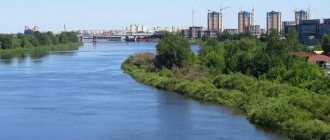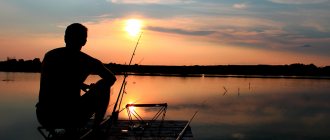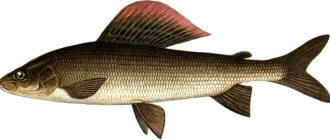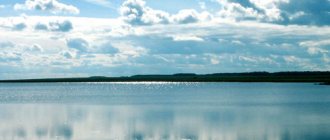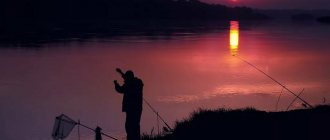Reservoirs of the region
Within the Amur region there are 44,000 rivers, lakes, ponds and other bodies of water, in which more than 100 species of different fish are found. The determining factor for fishing enthusiasts in the Amur region is that many of the listed fish in Russia are found only in the Amur basin.
Rivers of the Amur region
Map of rivers of the Amur region
Amur River
, flowing through the territory of the region, is replete with its ichthyofauna. There are more than 130 species of fish alone. Fishing in the Amur region is considered quite an exciting activity. Not a single fisherman will leave without a catch. In most cases, the catch consists of fish such as carp, grass carp, sturgeon, pike, lenok, whitefish, taimen and many others.
During spawning, chum salmon, Pacific lamprey and pink salmon appear in the Amur waters. The Amur region is rich in reservoirs. On its territory there are over 44 thousand different water streams, which are teeming with many different fish. Most fish species are endemic, i.e. These representatives live directly in the waters of this region and can no longer be found in other places. The most desirable catch for fishing enthusiasts, both local and foreign, are fish from the salmon family. Quite an exciting activity can be called fishing for snakehead, Chinese perch, Amur pike, rudd, yellowjacket and silverfish. The topgazer is worthy of special attention; in terms of strength, this fish can be equated to lenok or taimen.
The Zeya River is considered the second largest water artery of the Amur region
. Fishing in its waters is no less exciting and interesting. The main catch here is dace and taimen. Despite this abundance, the stormy waters of the northern part of the region are recognized as the most interesting places for fishing. Reaching these places is considered a miracle. The path lies through impassable jungle, but these difficulties will be generously rewarded. This is a real paradise for fishermen. In the fast waters of the river you can hunt for grayling, taimen or lenok. Going a little further downstream, you can safely catch burbot or whitefish. Fish species such as lenok and grayling are available to fishermen in many reservoirs flowing through the Amur region.
The Akishma River has an equally rich fauna.
, taking its origins on the slopes of Mount Aesop, located in the Khabarovsk Territory. Among the many mountain rivers, the following should be highlighted: Arga, Niman. Imanga, Getkan, Selemdzha, Bureya, Lucha, etc. In the flat expanses, rivers such as Berea, Belaya and Burma deserve special attention, which are considered one of the most attractive places for fishing.
There are also mixed types of rivers, including Zeya, Tom, Verkhnyaya Larba, Nora and Bryanta. A fairly large number of rivers flow through the region, and it is not possible to list them all. The only thing we can say for sure is that, no matter where you decide to go fishing, you will always leave with a good catch.
Lakes of the Amur region
The lakes of the Amur region are more than 25 thousand small reservoirs. Only 20 of them have an area of more than 1 sq. km. The biggest one is Ogoron. Its area is almost 2.8 sq. km. This is a floodplain lake with a maximum depth of about 5 meters. In the Zeya region there are many small lakes of karst origin, and on the slopes of the Tukuringra and Stanovoy ridges there are small lakes of glacial origin. Small lakes of glacial origin are no more than two meters deep and freeze to the bottom in severe winters. As a result, many fish die. Representatives of small breeds have adapted to winter in damp silt. They also easily tolerate complete freezing.
Fishing in the Amur region on the lakes is mainly fishing for pike, rotan, and snakehead. Salmon are found along the rivers. But catching it is most often prohibited.
Reservoirs of the Amur region
The real fishing in this region is on the reservoirs. Special water intakes for power plants were created on Bureya and Zeya. Later, fish were thrown into them. Today these are the most popular fishing spots. The Bureya Reservoir is home to taimen, lenok, and grayling. In winter, pike fishes well. The Zeya Reservoir is famous for omul, perch, and taimen. A lot of pike are being caught. There is also sturgeon. Those who want to get a good catch go to reservoirs rather than natural lakes.
Fishing rules in the Amur region
The main feature of fishing in the Amur region is its diversity: you can fish in one of the many rivers, and there are over 40 thousand of them, including mountain rivers, and there are also approximately 120 thousand lakes in the region. When going fishing, you should know that the days when fishing here was carried out uncontrollably are long gone. As in other regions of Russia, in the reservoirs of the Amur region, fishing rules must be observed, prohibiting, for example, fishing for autumn chum salmon during spawning, which is the period from the beginning of September to the second half of October. Fishing in the Amur region in August, accordingly, does not have such restrictions.
Fishing in the Amur region in the spring also has a number of features: in particular, you cannot fish in wintering pits. This ban comes into force in February, and fishing in these places begins only on April 20. Grass carp, which is considered a commercial fish here, is banned in the Amur region and amateurs are prohibited from catching it. You also cannot catch Pacific salmon in the wild; this is only possible with a permit. Naturally, all types of fish from the Red Book, as well as all types of sturgeon fish and young fish, are prohibited.
Fauna
The coast of the Zeya River has become a haven for different species of animals. East Asian deer (wapiti), wild boars, roe deer graze here, wild goats gallop along the steep slopes at the upper reaches, Ussuri moose and brown bears roam through the coniferous forests. Representatives of the mustelid family are widespread in the Amur region.
The Zeya River is mainly known for sables, ermines, otters, and wolverines. The natives of the coast are representatives of the canine family such as wolves and raccoon foxes.
The picturesque river and its surroundings are inhabited by a rich population of birds. Particularly common are hazel grouse and wood grouse. Unfortunately, in recent years the number of grouse has decreased significantly.
The Zeya River (Amur Region) is extremely rich in fish. Local waters are inhabited by Amur minnows, lenok, taimen, vladislavia, grayling, mustache loaches, minnows, pikes, whitefish, sculpin, Amur chebak, small smelt, burbot, silver carp and other species of fish.
For fishermen, the Zeya River is a real paradise. Here you can easily catch a 4-kilogram lenok and a 1.5-kilogram grayling. Taimen, weighing 40-50 kg, is considered a special trophy!
Given such a diversity of ichthyofauna, it is not surprising that fishing on the river is on a large scale. Nets are used for fishing purposes - the productivity is 0.8 kg of fish per hectare. Amateurs mainly fish with spinning rods, spoons and baitcasting reels.
Features of fishing in the Amur region
Fishing in the Amur Region
Fishing on the Amur is a real pleasure all year round. However, the warmest period from May to September can be called the most fruitful period. And this is no coincidence. It is in May that the mass “awakening” of insects begins. According to reviews from fishing enthusiasts, during the warm season, lenok, chub, and Kamchatka salmon come into their own hands.
The most productive fishing will be with live bait while boating. For example, in this way, pike and Amur leopard are caught better than others. In June-July, crucian carp bite well. In August there is a burst of activity of carp, which does not manifest itself at other times of the year. In autumn, the probability of bringing back Amur catfish weighing more than 5 kg from fishing increases.
On the river itself in the spring, it is best to use insects as bait. For a large predator, a spinner is also quite suitable. Summer fishing is good in August: crucian carp and carp are used with a float rod for a worm, pearl barley and corn; when fishing with a donk, you can also use a worm as bait and catch catfish or pike with it.
On rainy and cloudy days, spinners catch yellowjacket, snakehead, and pike using oscillating and rotating spoons; they rarely manage to catch something decent with wobblers.
In the fall, all spinning baits are used, and it is at this time that there is the greatest chance of catching a large predator fattening up for the winter, and more than one, since by autumn they stay close to each other. At this time, lenok and taimen bite equally well on spinners and live bait. In general, the predator invariably goes for live bait; at the end of autumn, you can also offer it worms. Fly fishermen use flies - both dry and wet.
In winter, the river is covered with durable thick ice that lasts up to 170 days a year. Under the ice, fishermen can expect a significant concentration of fish – both migratory and sedentary. The main target is not the frequently encountered toothy predator, but the whitefish. In addition, in mild frosts, bream, taimen, and lenok are active. Spoons are the most catchy among winter baits, and homemade ones are popular among local fishermen. Grayling is caught in shallow water by offering it a worm, bark beetle or artificial fly. Where the areas are deeper, in winter you can hunt carp using plant food - algae, reed stems, boiled pearl barley. When the waters are covered with ice, brown trout also greedily bite at the depths.
Paid fishing
Today there is paid fishing in the Amur region. This means that the reservoir is leased, the tenant provides the fisherman with certain conditions, monitors the reservoir and charges a fee for fishing. In the Amur region, all 27 paid fishing spots are managed by the Federal State Budgetary Institution Amurrybvod.
If you want to go fishing with a net as an amateur (I emphasize, we are not talking about commercial fishing), you can buy a ticket to the desired area. Most of the sites are located in the Zeya River basin from Novopetrovka to the city of Zeya. Several sections are located in Selemdzha, the first - from the mouth of the Selemdzha River to the village of Putyatino, the second - from the village of Uglovoye to Novorossiyka, another section is located in Ulm - from the mouth of the Toburachka River to the Sekta River. Plus areas on the Pervomaisky, Tambovsky, Tolstovsky and Novoaleksandrovsky reservoirs, on the Antonovsky reservoir in the Arkharinsky district. And, of course, fishing in the Zeya and Bureya reservoirs.
Fishing with nets is allowed in two periods:
- the first ends on May 25;
- the second will begin on July 25 and will last until the end of the fishing season.
The amounts for those wishing to use paid fishing services are not so large. Fishing in a standing reservoir will cost an average of 300 rubles, in a river - 350 rubles. The money collected goes to the needs of the organization, as well as to maintain the reservoirs in proper condition. You can pay for your trip today at any branch of Sberbank; the terminal has a special payment purpose for the Federal State Budgetary Institution Amurrybvod. You must take the permit with you on a fishing trip and present it in case of inspection. By the way, supervisory authorities can fine a fisherman if the weight of the fish caught is greater than the weight indicated on the voucher. And don’t forget that at the end of the fishing trip you need to register your permit with the Amurrybvod inspector.
Attention! Recently, cases of fraud have become more frequent - fishermen are often approached under the guise of inspectors and asked to pay, or their catch and gear are taken away. To avoid falling prey to scammers, always check your ID carefully. Keep in mind: if you took a voucher with you, after presenting it no one has the right to take anything away.
Paid fishing areas in the region
- Paid fishing on the Zeya River
- from Novopetrovka to Zeya. The best fish to catch are: crucian carp, pike, carp, catfish, silver carp, taimen. - Paid fishing on the Selemdzha River
- from the mouth of the Selemdzha River to the village of Putyatino. Best caught: crucian carp, pike, taimen. - Paid fishing on the Selemdzha River
- from the village of Uglovoye to Novorossiyka. Best caught: crucian carp, pike, taimen. - Paid fishing on the Ulma River
- from the mouth of the river. Toburachka to the river Sect. Best caught: crucian carp, pike, taimen. - Paid fishing - Zeya Reservoir
. The best fish to catch are: crucian carp, pike, catfish, yellowjacket, and silver carp. - Paid fishing - Bureya Reservoir
. The best fish to catch are: crucian carp, pike, catfish, yellowjacket, and silver carp. - Paid fishing - Pervomaiskoye Reservoir
. The best fish to catch are: crucian carp, catfish, yellowjacket, and silver carp. - Paid fishing - Tambov Reservoir
. The best fish to catch are: crucian carp, catfish, yellowjacket, and silver carp. - Paid fishing - Tolstoy Reservoir
. The best fish to catch are: crucian carp, catfish, yellowjacket, and silver carp. - Paid fishing - Novoaleksandrovskoye Reservoir
. The best fish to catch are: crucian carp, catfish, yellowjacket, and silver carp. - Paid fishing - Antonovskoye Reservoir
. The best fish to catch are: crucian carp, catfish, yellowjacket, and silver carp.
Geographical information
The river originates in the Tokinsky Stanovik ridge on the southern slopes of the Stanovoy ridge system. In the upper reaches, from the source to the mouth of Selemdzha, it has a predominantly mountainous character; here its valley is limited by high slopes. At the intersection of the Tukuringra Range, the river flows through a deep rocky gorge. Below the confluence of the Selemdzha, in its lower course, the Zeya comes out onto a plain, where its valley widens and the channel is divided into numerous branches.
The length of Zeya is 1242 km, the basin area is 233 thousand square meters. km.
The cities of Zeya, Svobodny and Blagoveshchensk are located on Zeya. In the upper reaches there is the Zeya Nature Reserve with an area of more than 830 square meters. km. Before the construction of the Zeya hydroelectric power station, catastrophic floods occurred on the river during summer floods. A cascade of Nizhnezeya hydroelectric power stations is being designed on the river.
The water supply is predominantly rainwater, the share of which makes up 50-70% of the total annual runoff. Snow accounts for 10-20%, underground - 10-30%. The Zeya is characterized by high water content: the average annual water flow in the lower reaches near the city of Blagoveshchensk is 2500 cubic meters. m/s. The greatest depth during low water is 64 m (Near the Western Hydroelectric Station, the greatest width is 4 km. The slope of the riverbed is within 0.1-0.4‰, in the upper reaches - more than 15‰. Current speed in the upper reaches is 4-6 m/s, in the lower reaches - up to 1.2 m/s.
The water regime, compared to other rivers of the Far East, is characterized by a more pronounced spring flood, which lasts on average 20-30 days, and high summer rain floods, sometimes causing severe floods.
In winter, the Zeya, whose basin is located in the permafrost zone, is extremely low in water. Near the city of Zeya, for example, during floods the influx of water reaches 14,200 cubic meters. m/sec and higher, and in winter it drops to 1.5 cubic meters. m/sec. Before the construction of the Zeya hydroelectric power station, the long-term amplitude of water level fluctuations reached 9-10 m. The river’s catchment area includes more than 19,800 lakes with a total area of 1,021 square meters. km.
The extremely branched system of tributaries of the river includes about 30 thousand watercourses, among which 43 are longer than 100 km. Main tributaries: Selemdzha and Gilyuy.
According to the State Water Register of Russia, the river belongs to the Amur Basin District, the river basin of the Amur River, the river sub-basin of the Zeya River, the water management section of the Zeya River from the source to the Zeya hydroelectric complex.
see also
|
|
|


